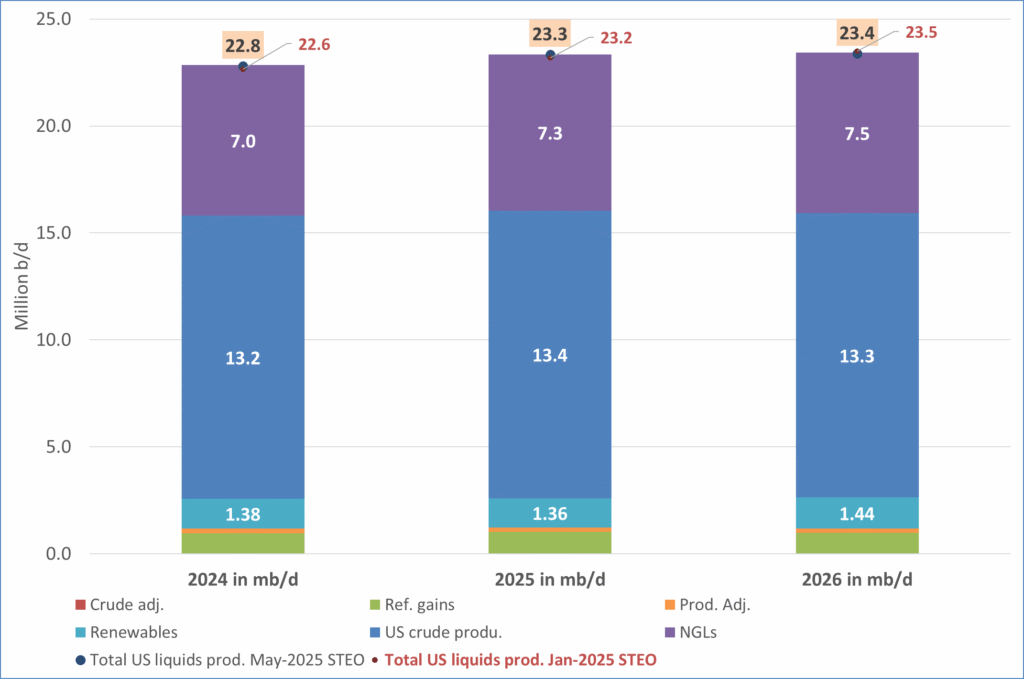Analys
Upside is the way to go both front end and back end. Go buy Brent Dec-2020 at $58/bl

 After hitting a fresh 2015 high of $64.65/bl last week on the back of spiralling geopolitical risk it is not too surprising that the front month Brent crude is taking a small breather. Yesterday it closed at $63.16/bl while it is pulling back another 0.5% to $62.8/bl this morning. The longer dated contracts like the Brent December 2020 have however continued to gain ground with a close yesterday of $58.13/bl. US inflation is currently running at about 2%. Assume simplistically that this is the inflation rate also the next three years to December 2020. The future Brent Dec-2020 contract is a nominal price. This means that in real terms (adjusting for 2% yearly inflation) the current Brent Dec 2020 is currently priced at $54.7/bl in real terms while it is $58.13/bl in nominal terms.
After hitting a fresh 2015 high of $64.65/bl last week on the back of spiralling geopolitical risk it is not too surprising that the front month Brent crude is taking a small breather. Yesterday it closed at $63.16/bl while it is pulling back another 0.5% to $62.8/bl this morning. The longer dated contracts like the Brent December 2020 have however continued to gain ground with a close yesterday of $58.13/bl. US inflation is currently running at about 2%. Assume simplistically that this is the inflation rate also the next three years to December 2020. The future Brent Dec-2020 contract is a nominal price. This means that in real terms (adjusting for 2% yearly inflation) the current Brent Dec 2020 is currently priced at $54.7/bl in real terms while it is $58.13/bl in nominal terms.
In other words consumers can still purchase forward the Dec-2020 at less than $55/bl in real terms. The frame work reflection around this is that US shale oil players are not making satisfying returns with a crude oil price of $50/bl. So the general assumption is that they need a higher price than that. What we also have seen since the start of the year and accelerating so over the latest months is that the Brent to WTI price has widened out as increasing production has hit pipeline export constraints in the US from Cushing Oklahoma to the US Gulf. It can be mended but it takes time.
A strong US crude oil production growth to 2020 is both needed and probable. But it requires more than $50/bl for US shale oil players. It is also likely to imply a wide Brent to WTI price spread. At the moment the WTI Dec 2020 contract is trading at only $52/bl. It should at least reflate up to $55/bl on the assumption that the global oil market will need a lot of US shale oil production growth to 2020. Currently the Brent to WTI Dec 2020 crude spread is a full $6/bl. This seems fair in a scenario of strongly increasing US shale oil production.
This kind of base assumption thus places Brent Dec-2020 outlook easily at $60/bl as some kind of floor-price assumption in a scenario where the world will need a solid growth in US shale oil production. Of course if we have a global recession in the run-up to 2020 there is no price floor to talk about and the oil price could obviously deliver below the $60/bl in that case.
However if we assume a Brent 2020 “floor price” of $60/bl then there is no geopolitical risk premium included in that price and there is no cyclical investment upside price spike risk included in that (investment cuts since 2014 leading to structural deficit in 2020. So consumers contemplating purchasing crude oil or oil products on the 2020 horizon should act as Brent Dec 2020 at a nominal price of $58/bl (and real price of $54.7/bl) is still a very, very good offer.
Our expectation is that the Brent Dec 2020 contract will reflate yet higher and into the $60is/bl.
We also expect the Brent to WTI price spread to widen out yet further. In its latest forecast the US EIA predicts US crude oil production to increase 15 kbl/day each week from December to May when it will hit 10 mbl/day. Thus US export pipelines and pipeline infrastructure is going to be under more and more pressure every week all the way to May at least. The WTI crude oil benchmark is priced in-land in Cushing Oklahoma and that price has to scream: “NO MORE” to US shale oil players even if the world needs more of it. The WTI price has to say stop becuse of lack of capacity to get it to market. Inventories there are already brimming full and rising as pipes to the US Gulf are already running full.
So again we have a two wheel crude oil world. Declining crude and product inventories in the world in total and especially the World ex-US-Mid-Continent while at the same time rising inventories in the US Mid-Continent with increasing bottlenecks and transportation issues. Thus a tightening Brent crude market on the one side and a weakening WTI crude market on the other side.
One possible hitch in this argument is however that Permian and Eagle Ford producers may not have to ship their crude oil through Cushing Oklahoma as they are further to the west. Is there enough pipline capacity from Permian and Eagle Ford to get their oil directly to the US Gulf circumventing Cushing? If that is the case then Permian and Eagle Ford producers are actually getting US Gulf crude oil prices for their crude oil which is close to Brent prices. That would mean that those two fields are currently experiencing STRONG price stimulus from US Gulf crude prices and not the WEAK Cushing Oklahoma WTI prices.
Our view on geopolitics is that we are now likely going to experience a long period with a continuous stream of uncomfortable and disturbing news coming out of Saudi Arabia specifically and the Middle East in General. Thus what Mohammed bin Salman set in motion a little more than a week ago is probably only the start of it. In the quite after the Saudi event a week ago the Brent price has eased back. Our expectation is that there is going to be more disturbing geopolitical news items in not too long. Inventories are still declining. OPEC and Russia are likely going to maintain cuts to the end of 2018 but no decision at upcoming OPEC meeting in Vienna on 30th November. Investors continue to flock into front end Brent backwardation positive roll yield and the upside is the way to go for Brent. Both for the front end contract as well as for the longer dated Brent Dec-2020.
Adding in geopolitical risks to the whole mix of declining inventories (ex-US-Mid-Continent), increasing Brent to WTI price spread, increasing Brent backwardation, strong global demand growth, positive Brent roll yield in a zero interest rate world sucking in more speculative long positions, well then seeing the Brent front month sniffing close to the $70/bl seems like the likely price action. Not long ago we said that it was likely to see Brent touching up to $65/bl before Christmas, but then we had no strong geopolitical driver in our assumption besides the Kurdistan issue. Now the central bank of oil, Saudi Arabia, is added to the mix of geopolitical concerns.
So upside is the way to go for the time being. Both for front end Brent and the Dec-2020.
Kind regards
Bjarne Schieldrop
Chief analyst, Commodities
SEB Markets
Merchant Banking
Analys
Brent crude ticks higher on tension, but market structure stays soft

Brent crude has climbed roughly USD 1.5-2 per barrel since Friday, yet falling USD 0.3 per barrel this mornig and currently trading near USD 67.25/bbl after yesterday’s climb. While the rally reflects short-term geopolitical tension, price action has been choppy, and crude remains locked in a broader range – caught between supply-side pressure and spot resilience.

Prices have been supported by renewed Ukrainian drone strikes targeting Russian infrastructure. Over the weekend, falling debris triggered a fire at the 20mtpa Kirishi refinery, following last week’s attack on the key Primorsk terminal.
Argus estimates that these attacks have halted ish 300 kbl/d of Russian refining capacity in August and September. While the market impact is limited for now, the action signals Kyiv’s growing willingness to disrupt oil flows – supporting a soft geopolitical floor under prices.
The political environment is shifting: the EU is reportedly considering sanctions on Indian and Chinese firms facilitating Russian crude flows, while the U.S. has so far held back – despite Bessent warning that any action from Washington depends on broader European participation. Senator Graham has also publicly criticized NATO members like Slovakia and Hungary for continuing Russian oil imports.
It’s worth noting that China and India remain the two largest buyers of Russian barrels since the invasion of Ukraine. While New Delhi has been hit with 50% secondary tariffs, Beijing has been spared so far.
Still, the broader supply/demand balance leans bearish. Futures markets reflect this: Brent’s prompt spread (gauge of near-term tightness) has narrowed to the current USD 0.42/bl, down from USD 0.96/bl two months ago, pointing to weakening backwardation.
This aligns with expectations for a record surplus in 2026, largely driven by the faster-than-anticipated return of OPEC+ barrels to market. OPEC+ is gathering in Vienna this week to begin revising member production capacity estimates – setting the stage for new output baselines from 2027. The group aims to agree on how to define “maximum sustainable capacity,” with a proposal expected by year-end.
While the IEA pegs OPEC+ capacity at 47.9 million barrels per day, actual output in August was only 42.4 million barrels per day. Disagreements over data and quota fairness (especially from Iraq and Nigeria) have already delayed this process. Angola even quit the group last year after being assigned a lower target than expected. It also remains unclear whether Russia and Iraq can regain earlier output levels due to infrastructure constraints.
Also, macro remains another key driver this week. A 25bp Fed rate cut is widely expected tomorrow (Wednesday), and commodities in general could benefit a potential cut.
Summing up: Brent crude continues to drift sideways, finding near-term support from geopolitics and refining strength. But with surplus building and market structure softening, the upside may remain capped.
Analys
Volatile but going nowhere. Brent crude circles USD 66 as market weighs surplus vs risk

Brent crude is essentially flat on the week, but after a volatile ride. Prices started Monday near USD 65.5/bl, climbed steadily to a mid-week high of USD 67.8/bl on Wednesday evening, before falling sharply – losing about USD 2/bl during Thursday’s session.

Brent is currently trading around USD 65.8/bl, right back where it began. The volatility reflects the market’s ongoing struggle to balance growing surplus risks against persistent geopolitical uncertainty and resilient refined product margins. Thursday’s slide snapped a three-day rally and came largely in response to a string of bearish signals, most notably from the IEA’s updated short-term outlook.
The IEA now projects record global oversupply in 2026, reinforcing concerns flagged earlier by the U.S. EIA, which already sees inventories building this quarter. The forecast comes just days after OPEC+ confirmed it will continue returning idle barrels to the market in October – albeit at a slower pace of +137,000 bl/d. While modest, the move underscores a steady push to reclaim market share and adds to supply-side pressure into year-end.
Thursday’s price drop also followed geopolitical incidences: Israeli airstrikes reportedly targeted Hamas leadership in Doha, while Russian drones crossed into Polish airspace – events that initially sent crude higher as traders covered short positions.
Yet, sentiment remains broadly cautious. Strong refining margins and low inventories at key pricing hubs like Europe continue to support the downside. Chinese stockpiling of discounted Russian barrels and tightness in refined product markets – especially diesel – are also lending support.
On the demand side, the IEA revised up its 2025 global demand growth forecast by 60,000 bl/d to 740,000 bl/d YoY, while leaving 2026 unchanged at 698,000 bl/d. Interestingly, the agency also signaled that its next long-term report could show global oil demand rising through 2050.
Meanwhile, OPEC offered a contrasting view in its latest Monthly Oil Market Report, maintaining expectations for a supply deficit both this year and next, even as its members raise output. The group kept its demand growth estimates for 2025 and 2026 unchanged at 1.29 million bl/d and 1.38 million bl/d, respectively.
We continue to watch whether the bearish supply outlook will outweigh geopolitical risk, and if Brent can continue to find support above USD 65/bl – a level increasingly seen as a soft floor for OPEC+ policy.
Analys
Waiting for the surplus while we worry about Israel and Qatar

Brent crude makes some gains as Israel’s attack on Hamas in Qatar rattles markets. Brent crude spiked to a high of USD 67.38/b yesterday as Israel made a strike on Hamas in Qatar. But it wasn’t able to hold on to that level and only closed up 0.6% in the end at USD 66.39/b. This morning it is starting on the up with a gain of 0.9% at USD 67/b. Still rattled by Israel’s attack on Hamas in Qatar yesterday. Brent is getting some help on the margin this morning with Asian equities higher and copper gaining half a percent. But the dark cloud of surplus ahead is nonetheless hanging over the market with Brent trading two dollar lower than last Tuesday.

Geopolitical risk premiums in oil rarely lasts long unless actual supply disruption kicks in. While Israel’s attack on Hamas in Qatar is shocking, the geopolitical risk lifting crude oil yesterday and this morning is unlikely to last very long as such geopolitical risk premiums usually do not last long unless real disruption kicks in.
US API data yesterday indicated a US crude and product stock build last week of 3.1 mb. The US API last evening released partial US oil inventory data indicating that US crude stocks rose 1.3 mb and middle distillates rose 1.5 mb while gasoline rose 0.3 mb. In total a bit more than 3 mb increase. US crude and product stocks usually rise around 1 mb per week this time of year. So US commercial crude and product stock rose 2 mb over the past week adjusted for the seasonal norm. Official and complete data are due today at 16:30.
A 2 mb/week seasonally adj. US stock build implies a 1 – 1.4 mb/d global surplus if it is persistent. Assume that if the global oil market is running a surplus then some 20% to 30% of that surplus ends up in US commercial inventories. A 2 mb seasonally adjusted inventory build equals 286 kb/d. Divide by 0.2 to 0.3 and we get an implied global surplus of 950 kb/d to 1430 kb/d. A 2 mb/week seasonally adjusted build in US oil inventories is close to noise unless it is a persistent pattern every week.
US IEA STEO oil report: Robust surplus ahead and Brent averaging USD 51/b in 2026. The US EIA yesterday released its monthly STEO oil report. It projected a large and persistent surplus ahead. It estimates a global surplus of 2.2 m/d from September to December this year. A 2.4 mb/d surplus in Q1-26 and an average surplus for 2026 of 1.6 mb/d resulting in an average Brent crude oil price of USD 51/b next year. And that includes an assumption where OPEC crude oil production only averages 27.8 mb/d in 2026 versus 27.0 mb/d in 2024 and 28.6 mb/d in August.
Brent will feel the bear-pressure once US/OECD stocks starts visible build. In the meanwhile the oil market sits waiting for this projected surplus to materialize in US and OECD inventories. Once they visibly starts to build on a consistent basis, then Brent crude will likely quickly lose altitude. And unless some unforeseen supply disruption kicks in, it is bound to happen.
US IEA STEO September report. In total not much different than it was in January

US IEA STEO September report. US crude oil production contracting in 2026, but NGLs still growing. Close to zero net liquids growth in total.

-

 Nyheter4 veckor sedan
Nyheter4 veckor sedanMeta bygger ett AI-datacenter på 5 GW och 2,25 GW gaskraftverk
-

 Nyheter4 veckor sedan
Nyheter4 veckor sedanAker BP gör ett av Norges största oljefynd på ett decennium, stärker resurserna i Yggdrasilområdet
-

 Analys4 veckor sedan
Analys4 veckor sedanBrent edges higher as India–Russia oil trade draws U.S. ire and Powell takes the stage at Jackson Hole
-

 Nyheter3 veckor sedan
Nyheter3 veckor sedanMahvie Minerals är verksamt i guldrikt område i Finland
-

 Analys4 veckor sedan
Analys4 veckor sedanIncreasing risk that OPEC+ will unwind the last 1.65 mb/d of cuts when they meet on 7 September
-

 Nyheter4 veckor sedan
Nyheter4 veckor sedanNeil Atkinson spår att priset på olja kommer att stiga till 70 USD
-

 Nyheter2 veckor sedan
Nyheter2 veckor sedanEurobattery Minerals satsar på kritiska metaller för Europas självförsörjning
-

 Analys2 veckor sedan
Analys2 veckor sedanOPEC+ in a process of retaking market share









